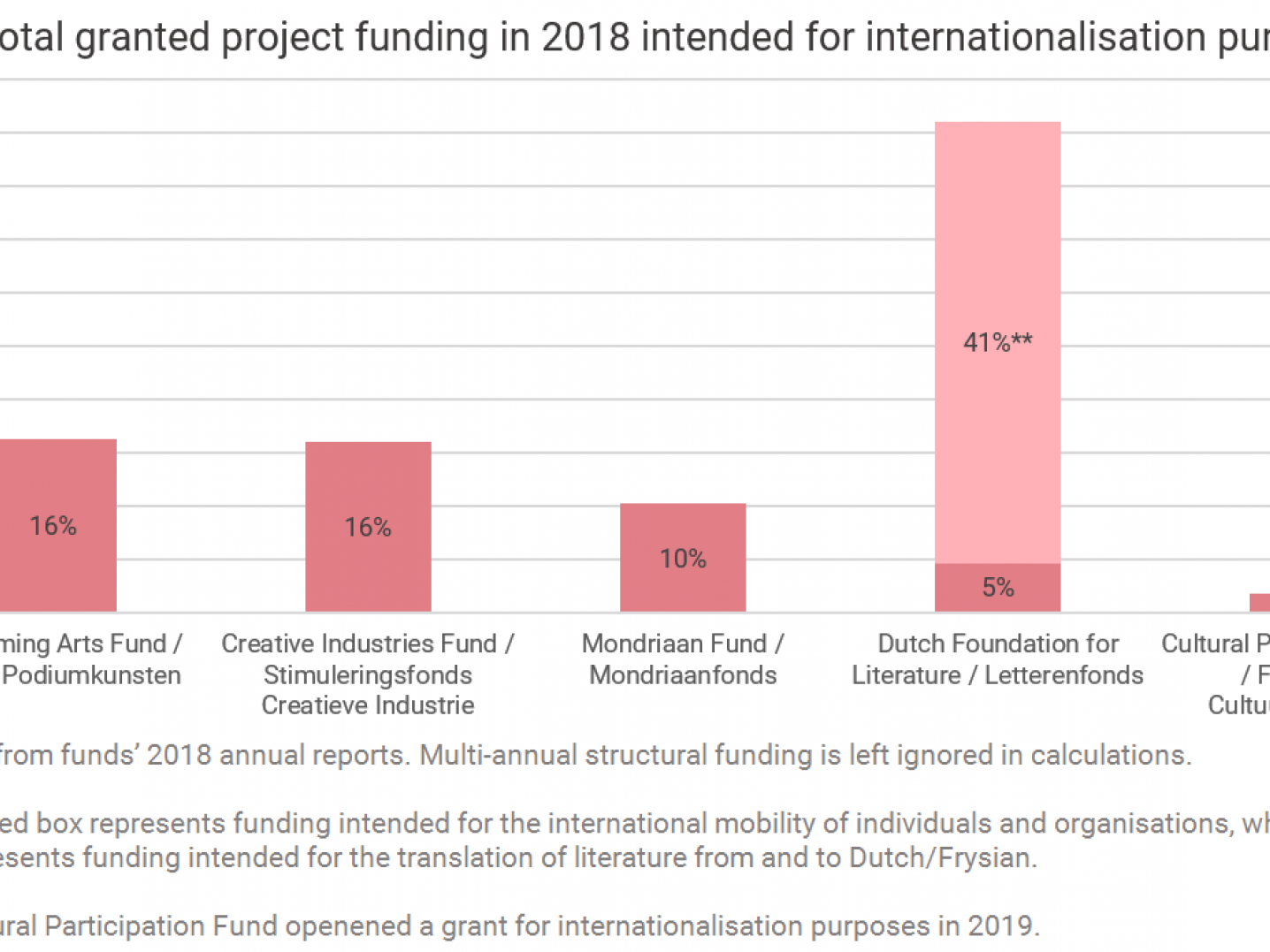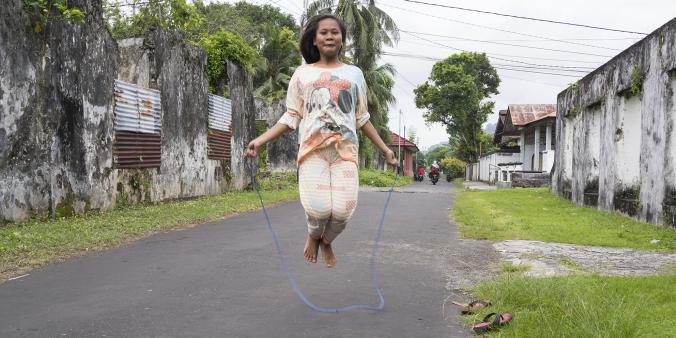
International or local funding, what works best for me?
In the Netherlands, most of the funding available for realising cultural and artistic productions and projects is limited to activities and presentations taking place within the nation’s borders by artists and cultural professionals living in the Netherlands. If you want to go abroad, or invite artistic partners from abroad, you are likely going to have to look at funding opportunities intended for internationalisation and international exchange. Yet, sometimes it might be possible to fund international activities with domestic funding or mixed funding. This article discusses the differences among these forms of funding and explain how your international project might benefit from them.
So tell me, where’s the money at?
Every year, the Dutch government invests a total of around 2.8 billion euros in culture (just over 1% of total government expenditure). Museums, public libraries, arts education, monumental restauration, funding for amateur and professional arts sectors – everything is paid from this budget. About 61% of this amount is administered by municipalities, 10% by the twelve provinces and 29% by the national government. Generally speaking, funding from municipalities is intended to contribute to arts and culture in that specific municipality, provincial funding contributes to the province, and national funding to the nation.
Additionaly, there is private funding for the cultural sector, made available by organisations such as Prince Bernhard Culture Fund, VSB Fund and the BankGiro Lottery. These organisations fund almost exclusively projects that take place within the Kingdom of the Netherlands, including Dutch overseas territories (though of course, there are exceptions). Although measurements differ, it is estimated that around 100 million euros is contributed to arts and culture by private funders each year.
What funding is available for internationalisation?
Internationalisation of the arts and cultural sector is – again, generally – a task ascribed to the national government. Cultural institutions directly funded by the national government are expected to be international players in their respective fields, and it is the Rijkscultuurfondsen (Mondriaan Fund, Dutch Performing Arts Fund, Film Fund, Creative Industries Fund, Dutch Foundation for Literature and Cultural Participation Fund) that, together with a number of cross-sectional organisations (of which DutchCulture is one) are responsible for executing the international cultural policy. Additionally, some municipalities, provinces and regional collaborations are also funding international cultural exchange. Regions like the Amsterdam Metropolitan Area, Brabant, the partnership between Friesland, Groningen and Drenthe (known as ‘We the North’) and Twente have the ambition to support international cultural exchange from 2021 onwards. Currently, however, funding for international cultural exchange is mostly done on the national level.
It is difficult to pinpoint the exact amount of cultural funding intended for internationalisation purposes: much of it is part of the funding received by cultural institutions operating at both national and international levels. But to give you some idea: the budget for the international cultural policy is around 18.3 million euros per year, and around 10-15% of the allocated project funding by the Rijkscultuurfondsen goes to programmes for internationalisation and international exchange.

Another international funding possibility is through the Creative Europe programme by the European Union. In 2018, Dutch organisations received almost 6,5 million euros from the MEDIA subprogramme for the audiovisual sector, as well as taking up their share of 24 million euros for the Culture subprogramme as part of a consortium. If we were to theoretically assume each partner to receive an equal share of the funding (which is not the case in reality), you would end up with 6,5 million euros from Creative Europe MEDIA and 4,8 million euros from Creative Europe Culture awarded to Dutch organisations in 2018.
What funding suits my international project?
So, does going international with your project open up the funding floodgates? No. Quite the contrary, it usually makes it more difficult. The first question you need to ask yourself, is whether your project really requires funding designated for internationalisation.
As a general rule, you can expect to be dependent on funding for internationalisation if:
- The presentation/realisation of your project takes place exclusively abroad. For instance, you’re booked by a foreign festival or venue as a performer, speaker or special guest. You’re asked to attend the opening of an exhibition of your work. Or, you’re participating in an international exchange abroad. The inviting organisation abroad may apply for funding, or you as an individual may apply for travel/mobility funding.
- You are collaborating/coproducing with an international partner. You are equal partners in the project, and there is a clear intention for exchange of knowledge and expertise. Further, there is either no public presentation of the results of your exchange, or this presentation exclusively takes place abroad.
You might be dependent on funding designated for internationalisation if:
- You are collaborating/coproducing with an international partner. You are equal partners in the project, and there is a clear intention for exchange of knowledge and expertise. And, there is a public presentation of the results of your exchange in the Netherlands.
- You are traveling abroad to do research on a project, with the intention of presenting the results of your research in the Netherlands.
As can be seen from the examples given, it is important to ask yourself what the purpose is of your going abroad. If it is to present yourself as an artist and/or your work in an international context, you will probably need to look for internationalisation funding. If you are collaborating or doing research abroad, it really depends what you want to do with your newly acquired knowledge and/or experience. If you are presenting it in the Netherlands or you are able to show that it will greatly benefit your artistic practice in the Netherlands, you could also look at whether locally or nationally oriented funders can contribute to your project.
Don’t be scared to ask
So, when you’re intending to go abroad and are looking for funding, make sure to keep an open mind about the possibilities. Maybe you can combine more locally oriented funding with international funding, or maybe you can think about a way in which focusing on particular aspects of your project might open up new funding opportunities.
In any case, whatever you do, don’t be scared to ask! Funders are usually happy to share their thoughts on the outlines of your plan and your propositions on making it financially feasible. Many funders even give you the option to give feedback on blueprints and drafts of your project plan.
Still want to learn more about working internationally and how to fund it? Here is what DutchCulture can do for you:
- Learn from those who went before you by consulting the DutchCulture database. The database registers Dutch presentations abroad across all countries and in every creative sector. Perhaps you can find organisations or individuals who did something similar and learn from their experience.
- Look into the International Cultural Policy and its focus countries. The International Cultural Policy has designated 17 focus countries for international cultural collaboration. This means that the Rijkscultuurfondsen give priority to projects taking place in or collaborating with these countries. Further, it means that Dutch Embassies in those countries can help you get in contact with local networks and sometimes even financially assist in your collaboration. DutchCulture’s country advisors can help you find the right contacts and tell you about the do’s and don’ts of working and collaborating in each specific country.
- Consult DutchCulture’s Cultural Mobility Funding Guide. The Mobility Funding Guide lists 85 different funding opportunities for artist mobility and internationalisation. DutchCulture’s Mobility Info Point can also assist in finding the right kind of funding for your project. You can contact DutchCulture’s Mobility Info Point through infopoint@dutchculture.nl.
- Consult the Creative Europe Desk NL website for more information on the Creative Europe Programme, the different grants available and how to apply.




